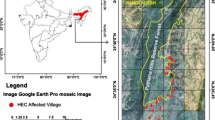
Overview
- Offers detailed analysis of the increasing man-elephant conflict in the forests of West Bengal, India
- Investigates the causes and consequences of habitat fragmentation in a very detailed, holistic, and in-depth manner
- Provides valuable information for ecologists, landscape conservation planners and environmental managers
- Includes supplementary material: sn.pub/extras
Part of the book series: SpringerBriefs in Environmental Science (BRIEFSENVIRONMENTAL)
Buy print copy
About this book
A major objective of this monograph is to identify the characteristics of man–elephant conflicts in terms of land use change, cropping patterns, ecological characteristics of the fragmented dry deciduous forest, trends and patterns of elephant migration, and livelihood patterns of the inhabitants in the affected areas. Readers will discover insights into changes in the behavioral pattern of elephants and localpeople in the conflict ridden zones, and how this influences food selection. Through this book we also learn about rational management strategies that can be employed on the local and national level to mitigate human-elephant conflicts.
Ecologists, landscape conservation planners and environmental managers engaged in the conservation of large vertebrates in fragmenting and human-dominated landscapes will find this book valuable.
Similar content being viewed by others
Keywords
Table of contents (8 chapters)
-
Front Matter
-
Back Matter
Authors and Affiliations
About the author
Bibliographic Information
Book Title: Man–Elephant Conflict
Book Subtitle: A Case Study from Forests in West Bengal, India
Authors: Nilanjana Das Chatterjee
Series Title: SpringerBriefs in Environmental Science
DOI: https://doi.org/10.1007/978-3-319-31162-3
Publisher: Springer Cham
eBook Packages: Earth and Environmental Science, Earth and Environmental Science (R0)
Copyright Information: Springer International Publishing Switzerland 2016
Softcover ISBN: 978-3-319-31161-6Published: 07 October 2016
eBook ISBN: 978-3-319-31162-3Published: 29 September 2016
Series ISSN: 2191-5547
Series E-ISSN: 2191-5555
Edition Number: 1
Number of Pages: XXIX, 179
Number of Illustrations: 1 b/w illustrations, 125 illustrations in colour
Topics: Environmental Management, Fish & Wildlife Biology & Management, Geographical Information Systems/Cartography, Animal Ecology, Forestry Management, Landscape Ecology



